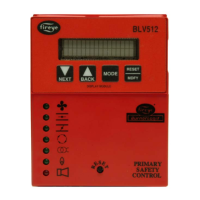© 2023 Carrier 30
WIRING
Attach the cable supplied with the scanner to a junction box. Splice the cable wires to a pair of wires not
smaller than #l8. Install the complete run in a separate conduit to the control. Continuous conduit bonding
between scanner and the control is mandatory! Scanner may be located up to 100 feet from control. Do not
pass scanner wiring through any junction box containing other wires. Do not run other wires through scanner
conduit. Asbestos insulated wire must be avoided.
9. To avoid nuisance shutdowns, avoid sighting hot refractory and to keep your scanner temperature
low below 140° F (60°C).
10. When the proper position has been established, drill a hole through the furnace wall and install a 4" to
8" (101.6mm x 203.2mm) length of threaded l/2" black iron pipe on which to mount the 48PT2 scanner.
11. When satisfactory sighting position has been confirmed by operating tests, the sight tube must be firmly
welded in place.
OPERATION - IR LEARN
(For IR Models prior to Version 12 only)
The BurnerLogix IR learn adapts the operation of the amplifier to the actual burner environment. 'Out of the
box', the BurnerLogix IR system is shipped with its sensitivity and thresholds set to detect most firing
conditions and does not require learning. The purpose of the LEARN process is to maximize reliable flame
detection over a wide range of conditions. The learn process sets the optimum values for the flame on and
flame off thresholds during pilot trial for ignition and the main firing period separately. The LEARN process
allows the BurnerLogix system to better differentiate between real and simulated flame conditions. Simulated
flame can be caused by burner throat modulation, radiation from the refractory tiles, or steam atomization. The
result of this technique of flame detection assures a positive flame out response for usual or adverse conditions.
Although it is not necessary to perform an IR LEARN, it is suggested this be done as part of the installation
process or when the 48PT2 scanner is changed.
The type of burner and fuel will affect the amplitude and radiation characteristics of the flame. Gaseous flames
tend to have low amplitude and radiation whereas oil flames have a high amplitude and radiation. On burners
having the option to fire both gaseous and oil fuels, it is recommended the LEARN process be performed on
the condition that has the lowest signal level. Normally this condition is gas at low fire.
The LEARN process in the BurnerLogix system is initiated through the keypad display module. The menu
item is located under the PROGRAM SETUP menu and is called DO IR LEARN. Refer to the section titled
'SETTING PROGRAMMER PARAMETERS' for information on setting operational values. Since the
default value is NO, the user must modify this value to YES.
MDFY TO CHANGE
DO IR LEARN YES

